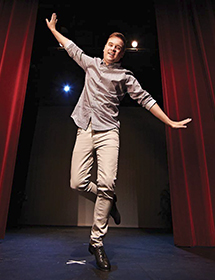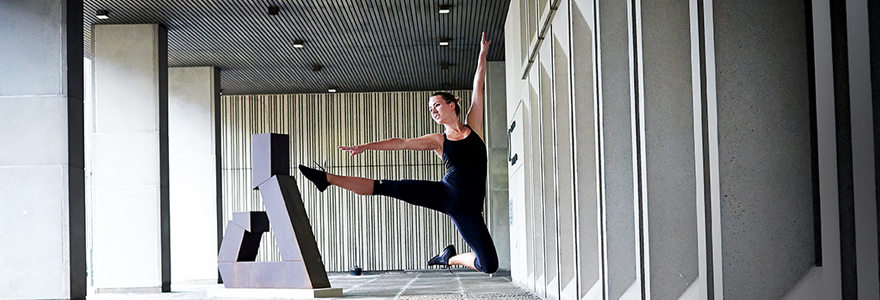Artistic expression
From day one of their studies, Schulich Medicine & Dentistry students are encouraged to pursue extracurricular activities to reinvigorate their minds and spirits.
By Jennifer Parraga, BA'93
Known as the hardest working internal organ, the heart keeps the body functioning.
As it flushes blood through the aorta, by design, it nourishes its own muscle with oxygen-rich blood through the coronary arteries.
Only when it’s nourished can the heart do its job and pump blood to the rest of the body.
This is a sentiment extracted from Dr. Irena Druce’s artist statement for White Coat Warm Art, a national medical student/practitioner art exhibit. Alumna Carol Ann Courneya, MSc’82, PhD, is the founding director of the exhibit. She also serves as the Assistant Dean, Student Affairs, Faculty of Medicine at The University of British Columbia, a role focused on providing support to students.
A cardiac physiologist, she took her research in a different direction more than a decade ago, and has been investigating the impact and value of visual arts for medical students.
Her recent study published in Arts and Health, showed that through art-making students could process stress and facilitate their learning. It was also identified that art-making helped students to bear witness to the suffering of others. And in the end, students indicated that they believed the artistic process would help them to be better practitioners.
Dr. Terri Paul, MD’82, associate dean, Learner Equity & Wellness, Schulich Medicine & Dentistry, whole-heartedly agrees. She believes it’s vitally important for students to have more in their lives outside of the classroom or lab. “Doing something intensive that is completely different from your studies, gives you that release and balance you need to strengthen your resolve and be successful,” she said.
As a choral singer during medical school, Dr. Paul experienced many benefits of performance art during her undergraduate studies. It provided her with the opportunity to hone her communication and observational skills, which are critical for anyone working in a health care or lab setting. “When you are on stage performing, you feed off of those around you. You learn to see the unspoken, and understand what’s best for the team,” said Dr. Paul.
From day one of their studies, Schulich Medicine & Dentistry students are encouraged to pursue extracurricular activities to reinvigorate their minds and spirits.
Whether it’s through dance, acting, music or the visual arts, when students create art, they are taking time for self-care and finding balance, enabling them to better care and support others, and become successful team players.
“I love being able to forget the other things going on in my life, when I am dancing,” said Camilla Stepniak, Medicine Class of 2016. “It’s my form of meditation and it helps to put things into perspective. It refuels me every time.”
Stepniak began dancing at the age of three. Jumping and twirling around the house in Disney princess dresses soon gave way to formal classes and competitive dance. With each year, her love of dance grew. From tap and jazz to contemporary, hip-hop and ballet training; the more she gave to dance the more she received from it.
Amidst the whirlwind during the first weeks of medical school, Stepniak learned about the many performance and dance opportunities made available to students through activities such as Tachycardia, Med Games, and talent- shows. There were also student organized workshops introducing alternative styles of dance such as Bollywood and ballroom. And not only was she able to perform, she could share her love of dance by teaching others
Apart from the sheer joy she receives from dance, Stepniak believes her training has helped her to develop a strong work ethic, to grow personally, to achieve her goals and create balance in her life. “I wouldn’t be where I am today without that balance,” she said.
“Today, our students are more aware of the need for balance during their studies. They are also more vocal and aware of their own wellness.”
- Dr. Terri Paul
 Of all his recent accomplishments, Eliot Winkler, BSc’13, MSc’15, is most proud of completing his master’s in Clinical Anatomy. The two-year intensive program took Winkler from the classroom to the lab. Add to that his volunteer work as a clinical anatomy outreach instructor, as well as with Let’s Talk Science— there were times when he felt overwhelmed.
Of all his recent accomplishments, Eliot Winkler, BSc’13, MSc’15, is most proud of completing his master’s in Clinical Anatomy. The two-year intensive program took Winkler from the classroom to the lab. Add to that his volunteer work as a clinical anatomy outreach instructor, as well as with Let’s Talk Science— there were times when he felt overwhelmed.
The stage offered him a reprieve from his schoolwork. A musical theatre junkie, acting, singing and dancing gave him a way to de-stress. “Theatre was an extremely good outlet to get a break from science,” he said. “It gave me an opportunity to step in someone else’s shoes and see the world from a different perspective.”
It all began for Winkler with the role of peasant number 32, in an elementary school production of Les Misérables. From then on Winkler had found the place that made him happiest—the stage.
During his undergraduate and graduate studies at Western, he explored his passion for music and acting through Theatre Western and Kings University College Chamber Choir. Experience gained through ensemble parts in Legally Blonde, Xanadu, Rent and I Love You, You’re Perfect, Now Change, culminated in his favorite role to date: Florinda—Cinderella’s evil step sister in the musical Into the Woods.
Winkler attributes part of his success during his graduate studies to the supportive environment offered through the Department of Anatomy and Cell Biology and the change of pace acting and singing offered him. “I love singing, and I love the people I meet when doing shows. It just makes me happy to perform,” he said.
While Stepniak and Winkler found their bliss on stage, Dr. Grant Vezina, DDS’15, found his thanks to a century-old family heirloom.
It was the grand and resonant sounds of a pianola, also known as a player piano, that inspired him to play the piano.
From the moment his hands touched the keys he felt great contentment.
Playing from a young age, Dr. Vezina believes music has helped him academically. It created in him a motivation and discipline to practise, improved his study habits, and offered a break from intense and focused study periods.
“I always admire the artistic person. They bring something different to the table; they think outside the box, and in doing so can change a whole practice,
hospital or lab.” - Dr. Terri Paul
 “There’s no question the academic and clinical aspects of the dentistry program are all consuming,” said Dr. Vezina. “But you need other pursuits to bring balance to your life. Whether it’s music or something else, they are important to keep your mind ready to face the challenges you will undoubtedly encounter.”
“There’s no question the academic and clinical aspects of the dentistry program are all consuming,” said Dr. Vezina. “But you need other pursuits to bring balance to your life. Whether it’s music or something else, they are important to keep your mind ready to face the challenges you will undoubtedly encounter.”
For Kelly Bullock, a master’s student in neurophysiology, art is a form of meditation. “If I’m stressed it can be incredibly calming,” she said. “It clears my mind. It puts me in a flow state where I’m not thinking; I’m not worried; I‘m focused on the movement,” she said.
Bullock experienced what she describes as a personal renaissance, when she was 14 years old. For her birthday that year, she received a special gift from her grandmother, the book, The Brain that Changes Itself, by Norman Doidge, MD. The stories were captivating and instilled in her a desire to pursue a career in neuroscience. Coincidentally, it was also the year when she started drawing portraits and sketching with graphite.
 She realized early on how calming and relaxing drawing was. That coupled, with the positive feedback she received, was all she needed to continue with her art.
She realized early on how calming and relaxing drawing was. That coupled, with the positive feedback she received, was all she needed to continue with her art.
Inspired by the movie Interstellar, Bullock recently began using watercolor to capture nebulae. Her paintings of the interstellar gas and dust have a peaceful, almost dreamlike quality to them.
In addition to the calming aspects of the pursuit of art, she finds it enormously satisfying. “It’s incredibly rewarding and fulfilling, to dedicate 40 hours to produce something that no one else ever has,” she said.
Emma Bluemke, a medical biophysics student, derives the same satisfaction from painting. “I find an existential pleasure in creating art,” she said. “I’ve noticed that I can complete a full school year and only have grades and lab reports to show for my work. I begin to feel as though something is missing, and if I haven’t produced something tangible in a while, I return to making art.”
 Bluemke grew up in a home surrounded by music and art. While she loves music—her true artistic passion is painting. Describing it as her close-to-the-heart hobby, she produces striking images using oils on natural wood, using the grain of the wood to capture movement and dimension.
Bluemke grew up in a home surrounded by music and art. While she loves music—her true artistic passion is painting. Describing it as her close-to-the-heart hobby, she produces striking images using oils on natural wood, using the grain of the wood to capture movement and dimension.
Although only entering her third year, Bluemke is making a name for herself on campus with her art. She was recently featured in the School’s pictorial calendar, and had one of her paintings profiled in a publication for the Faculty of Arts and Humanities.
With plans to pursue a career in medical imaging, Bluemke believes her art will remain a hobby—one that gives her a true feeling of pleasure and brings balance to her life. “I picture myself as a scientist first,” said Bluemke with a smile, “a scientist who also creates beautiful things.”









